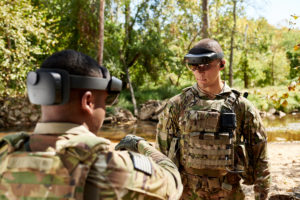The Army is modeling its restarted Optionally Manned Fighting Vehicle (OMFV) acquisition approach on the successes developing the service’s future augmented reality headset, with an emphasis on iterating program “characteristics” over mandating more stringent requirements.
Army Secretary Ryan McCarthy told attendees at the McAleese Conference on Wednesday the Bradley vehicle replacement competition will follow the lead of the Integrated Visual Augmentation System (IVAS) program by taking advantage of Other Transaction Authority agreements to better leverage vendors’ engineering developments.

“In this evolution, it’s very similar to what we’re doing with the IVAS program. We’ll have five OTAs that will go out to companies. They’ll come back with [software] drawings and will refine those. And then they’re going to bend metal,” McCarthy said. “We’re giving them a little more time. The previous strategy was short and very quick. So we’re allowing a little more of this latitude for the manufacturers to try to unleash more of their engineering talent and ideas to help us solve the outcome.”
The Army said in mid-January it would cancel its acquisition effort for OMFV, which faced scrutiny after a single bid sample from General Dynamics [GD] was accepted for the program’s prototype phase, re-focusing on multi-phased approach built around “digital design” with no firm timelines yet for a production decision or fielding.
Last week, the Army released its new list of nine characteristics for the restarted OMFV competition, detailing a broad problem set for the program to be refined through collaboration with industry rather than offering prescriptive requirements (Defense Daily, Feb. 25).
McCarthy and Gen. McConville, the Army chief of staff, told lawmakers on Tuesday during a House Armed Services Committee hearing when pressed on the new acquisition strategy that they personally got involved in the OMFV reboot to ensure it was modeled after IVAS, when pressed on the strategy for the competition (Defense Daily, March 3).
“It’s as much about the acquisition tools, the contractual mechanisms, as it is about how you’re organized against the problem. And that’s what we’re bringing to OMFV. A lot of success over with [with IVAS] and we’re trying to benchmark against best practices,” McCarthy told reporters following his discussion at the conference.
IVAS is currently being built by Microsoft [MSFT] with fielding to begin in 2021 and plans in the service’s latest budget request to purchase over 40,000 headsets.
Bruce Jette, the Army’s top acquisition official, also told reporters the decision to go with a characteristics document for OMFV was pulled directly from successes working through 14 variations of IVAS.
“There have been 14 IVAS models, they’ve built 14 variants of IVAS. It’s easier with IVAS. It’s a relatively small thing, you can do 3D printing. I can’t do 14 OMFVs to mature the requirement. So what we’re doing, similar to IVAS, is the new program will have a set of characteristics. We’ll work with industry to hear their feedback, inputs and have them tell us what we should consider,” Jette said.